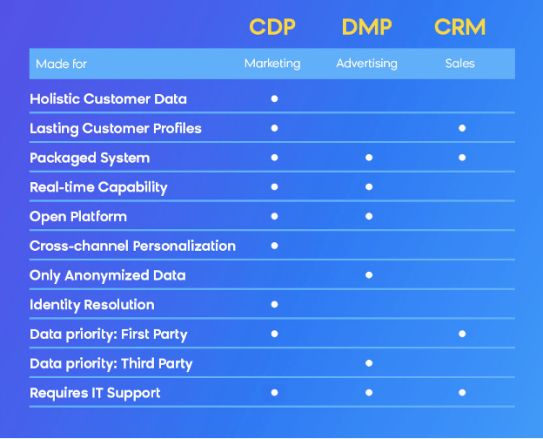
Key Features & Benefits of Customer Data Platforms and comparison to CRM & DMP
In this blog, we go over the features and capabilities of Customer Data Platforms (CDPs) and how they compare to CRM and DMP systems.
Customer Data Platforms (CDP): The features behind the benefits
According to Gartner’s 2019 Multichannel Marketing Survey, 58% of the respondents indicated leveraging integrated customer data was a significant or moderate challenge. This is where customer data platforms come into play: the go-to solution to collect, unify, analyze, and activate customer data in a single centralized platform.
A customer data platform functions as a marketing system that unifies a company’s customer data from marketing and other channels, to enable customer modelling and optimize the timing and targeting of messages and offers (Gartner). A CDP builds a complete profile of each of your individual customers through the collection and linking of first-party data to individual profiles. They are ready-to-use solutions, allowing departments without a high level of technical resources or skills, like marketing, to manage, analyze and use that data immediately after the initial technical implementation and set-up.
To read more about CDPs and their benefits.
The features of all CDPs, regardless of the provider, can be categorized into three main core capabilities:
1. Unifying high-quality customer data flowing in from disconnected channels.
2. Analyzing customer data at both a segmented and individual level.
3. Activation of that data across other channels.
Customer data unification
The first task of a CDP is to collect data and input from any source that generates or stores customer data. To assist them with this task, CDPs use easy-to-implement connectors that help you integrate this data.
Through integrations, a CDP can collect the following data:
- Events: behavioral data that arise from a user’s actions in a session on a website, in an app, a mobile browser, or interactions with wearables and IoT.
- Customer attributes: these include names, addresses, contact details, and birthdays. Advanced CDPs can also store machine-learning powered predictions, such as likelihood to purchase.
- Transactional data: purchases, returns, and other info from e-commerce or POS systems, both online and in-store.
- Campaign metrics: engagement, reach, impressions, and other metrics from campaigns across all advertising platforms and channels.
- Customer service data: live chat data, number and length of interactions, frequency, loyalty status, NPS scores, other data from CRM systems.
After this data ingestion, it is essential to run an initial technical setup to define the rules and processes the CDP needs to clean up and transform or enrich the data to meet our requirements. When this is done, the CDP requires little technical maintenance to execute these tasks, and the customer data is conveniently stored in a single source of truth.
Creating a single customer view
The data that comes from this single source of truth is trusted, and processed in a way that allows it to be unified into individual customer profiles. All these data points are grouped in individual profiles and allow you to identify a user on your website as the same person. This includes both: customers that bought an item at your physical store and new users that just put an item in their basket online after seeing your ads. Knowing all touchpoints of the customer journey that someone interacts with also provides insights into their interests, what they’re likely to buy next, or if they need a personal discount to re-engage them after some time of inactivity. This allows you to tailor each of your communications to their behaviour, and guarantee you’re always relevant across all channels.
Identity resolution
One of the key features that differentiate CDPs from other solutions is identity resolution. A CDP is capable of attributing multiple data points, including all disparate data collected across different channels during the customer journey, to the same individual customer profile. Additionally, CDPs can still track and store data coming from anonymous users through cookies and are able to fully identify these users and provide more context regarding the pre-purchase stages of their customer journey.
Customer Data Analysis & Activation
Once the CDP has ingested and unified this data into individual profiles, it’s ready to be analysed. The analytical capabilities of CDPs allow for several types of analysis:
- In-depth analysis of your individual customers:
This use case allows for in-depth data analysis of your current customer base to find out more about their preferences, the attributes of your most loyal customers (so you can learn how to grow your customer base by reaching new potential customers), to identify and reward high-value customers, and to identify customers that are underserved in order to grow their CLV. - Real-time audience segmentation:
Group active consumers that share certain attributes into segments using real-time audience segmentation. This allows you to create specific target audiences for your campaigns and craft the messaging taking their shared values, goals, or preferences into account. - Journey analytics:
Learn what the most profitable channels are to bring in customers and how to keep them engaged. Find out which touchpoints contribute the most to the growth of your revenue, and which ones underperform so you can set out to improve them.
Customer Data Activation
After your CDP has ingested the data from other systems and channels, unified it into individual customer profiles, and analyzed it in a way that either provides deeper customer insights or helps you create customer segments to target, you are ready to start sending high-quality customer data to the right marketing channels.
Here are some use cases to illustrate:
- Engage with customers in real-time, with fully personalized content: CDPs real-time data capabilities enable you to deliver tailored user experiences at the right micro-moment.
- Optimize your marketing expenditure by targeting audiences with specific content and timing, based on additional insights into the customers’ preferences and intent.
- Understand what each of your customers' needs is, so you can create completely personalized e-commerce experiences and product recommendations throughout your webshop.
What are the differences between CDP vs. CRM & DMP?
A comparison between CDP, CRM & DMP
The types of solutions in the Martech landscape continue to grow, and sometimes they may seem to have overlapping features or capabilities. This makes it much harder for marketers to find the right solution for their needs, or figure out how these systems can work together. This holds true for CDPs, DMPs, and CRMs alike. They all help digital marketers work with customer data, but are very different at the same time. And more specifically, it’s the difference in the way these solutions collect data, and the exclusive features they offer, that’s essential to identify.
CRM
A Customer Relationship Management system stores data from current and known customers, as well as from new users, capturing the direct interactions they have with the brand across several channels. This system focuses on transactional data to simply understand the who, when, and how of specific purchases. Sales and customer relationship teams use CRMs to capture, track, and manage the details needed about customers, prospects, and suppliers. Some of this data must be entered manually, however.
DMP
A DMP collects and connects data from multiple channels related to the marketing campaigns and their targeted audiences, to help marketers reach the right people with advertising. However, this data is only stored for a short period of time. The data collected is mostly anonymous and third-party, so it doesn’t allow for the creation of individual customer views.
CDP
Unlike a CRM and DMP system, a CDP collects all data from online and offline sources in real-time, from both known and anonymous visitors engaging with your brand across any channel, and is able to match all these interactions with a single customer profile. This creates a 360 view of all users that interact with your brand across any channel and captures the development of your relationship along the customer journey. This greatly increases both the amount of data you gather and its usability, as it’s all centralized in a single platform.
To summarize, DMPs and CRMs are capable of providing a snapshot of a specific part of the customer profile, whereas a CDP provides comprehensive and persistent customer profiles. When a CDP is integrated together with a DMP, it can provide significant value to organizations by allowing you to understand and benefit from both 1st and 3rd party customer data.

Source: Exponea
CDP growth is booming. Customers expect highly personalized experiences when they engage with companies, across all channels. They also expect that you know not to bother them with ads featuring products that don’t match their interests and preferences. However, the most important challenge to providing a relevant omnichannel experience is overcoming any internal or external misalignments. CDP’s capabilities help bridge these potential gaps, eliminate data silos, create highly detailed individual customer profiles, and enable the usability of that data. Applying this customer data has endless use cases across all your marketing channels, commerce platforms, and applications.
Read the full guide on CDPs ➔
Did we pique your interest?
Get in touch to discuss how we can drive your digital success.
Contact Us



